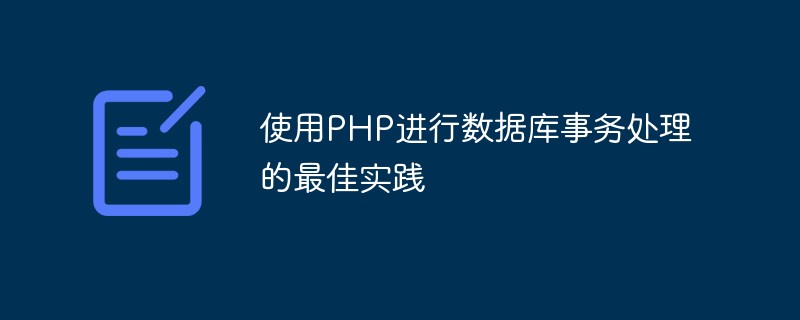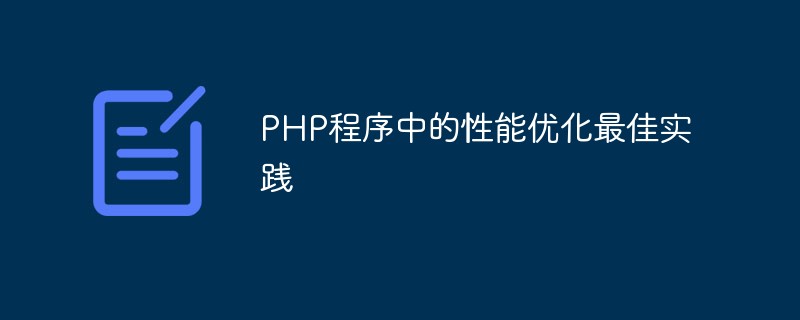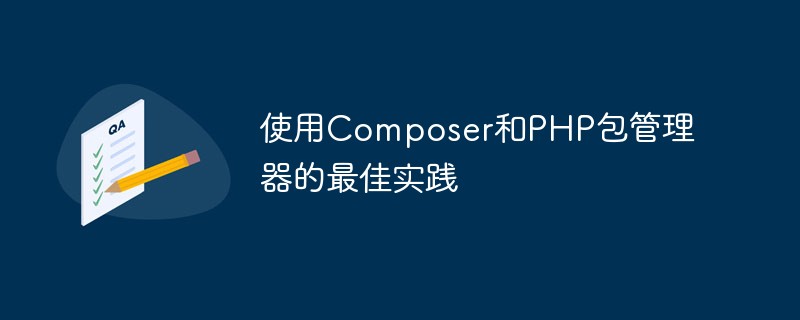Golang is a very popular programming language, not only because of its excellent efficiency and performance, but also because it is very easy to learn and use. Functions are a very important concept in Golang. Functions can not only help us organize code, but also simplify code logic. However, certain precautions and best practices need to be followed when using functions. This article will summarize the precautions and best practices for using Golang functions.
- Command specifications
In Golang, function names must start with a capital letter before they can be called by other external modules, while functions starting with a lowercase letter can only be used inside the module. . When writing function names, you should use camel case naming and try to include verbs in the function name, such as: GetUserInfo().
- Function parameters
The parameter passing methods of functions in Golang include value passing and pointer passing. When value type data (such as int, float, string, etc.) is passed to a function as a parameter, the function will make a copy of the parameter for operation, which can avoid the impact on external variables. But when a pointer is passed as a parameter, the function can modify the value of the original variable through the pointer. Therefore, when defining function parameters, you need to choose the appropriate transfer method according to the actual situation.
- Return value type
In Golang, functions can have multiple return values, which makes the return value of the function very flexible. When defining a function return value, you need to clarify the type and number of return values, and try to introduce error information into the return value. You can use a named return value for the return value, so that you can use the return statement directly in the function body to return the value without writing another part of code to return it.
- Visibility of functions
The visibility of functions defined in Golang is similar to other variables. Private functions start with a lowercase letter and can only be defined in the package in which the function is defined. used in. Public functions must start with a capital letter and can be called directly in other packages. At the same time, for larger projects, you can use doc comments to provide more detailed information and usage scenarios for functions, making it easier for other people to understand the role of the function.
- Single Responsibility
One principle that needs to be followed when designing a function is "single responsibility", that is, a function should only handle one function exclusively, rather than handle multiple functions. unrelated functions, which makes the design of the function simpler and more readable.
- Error handling
When writing a function, you need to consider error handling, that is, error conditions that may occur in the function. Golang provides a simple and easy-to-understand error type, which can contain information such as error messages and error codes. For operations that may fail, the function should return error information directly to the caller, and the caller can handle it accordingly based on the error information.
- Create test cases
When writing functions, you need to create correct test cases for them. These test cases can verify whether the expected return value and processing result of the function meet the requirements. Test cases can effectively ensure the correctness and stability of functions, and also help programmers reflect on possible problems when writing functions, improving code quality and maintainability.
- Function closure
Function in Golang also supports the concept of closure, that is, a function can reference and modify variables in its outer scope. Closures are more common in handling asynchronous events, such as file reading, network requests, etc., because they can pass data without introducing global variables.
Summary:
In Golang, function is a very important concept that can help us organize code and simplify code logic. When using functions, you need to follow some precautions and best practices, such as command specifications, function parameters, return value types, etc. At the same time, you need to follow the "single responsibility" principle when designing functions, and consider error handling and establishing test cases. If you need to handle asynchronous events, you can use closures and other solutions. In short, the use of Golang functions is flexible and can make the code more concise and easier to maintain.
The above is the detailed content of Summary of precautions and best practices for using Golang functions. For more information, please follow other related articles on the PHP Chinese website!
 使用PHP进行数据库事务处理的最佳实践Jun 07, 2023 am 08:00 AM
使用PHP进行数据库事务处理的最佳实践Jun 07, 2023 am 08:00 AM在Web开发中,数据库事务处理是一个重要的问题。当程序需要操作多个数据库表格时,保证数据一致性和完整性变得尤为重要。事务处理提供了一种方法来保证这些操作要么全部成功,要么全部失败。PHP作为一门流行的Web开发语言,也提供了事务处理的功能。本文将介绍使用PHP进行数据库事务处理的最佳实践。什么是数据库事务?在数据库中,事务是指一系列操作作为一个整体来执行的过
 PHP程序中的性能优化最佳实践Jun 06, 2023 am 09:20 AM
PHP程序中的性能优化最佳实践Jun 06, 2023 am 09:20 AMPHP是一种流行的编程语言,被广泛用于网站和Web应用程序的开发。然而,当PHP应用程序变得越来越复杂时,性能问题也会显现出来。因此,性能优化成为了PHP开发中的一个重要方面。在本文中,我们将介绍PHP程序中的优化最佳实践,以帮助你提高应用程序的性能。1.选择正确的PHP版本和扩展首先,确保你是使用最新的PHP版本。新版本通常会改进性能并修复bug,同时也会
 PHP程序中的面向切面编程最佳实践Jun 07, 2023 am 08:01 AM
PHP程序中的面向切面编程最佳实践Jun 07, 2023 am 08:01 AM随着互联网技术的不断发展,PHP语言作为一种开源的脚本编程语言在Web应用程序开发中广受欢迎,而面向切面编程(AOP)则是PHP程序员日常工作中的重要组成部分之一。AOP是一种程序设计方法,它在主业务逻辑代码执行过程中插入针对横切关注点的代码,这些代码可能涉及到日志记录、异常处理、缓存控制等方面。在本文中,我们将介绍PHP程序中的AOP最佳实践。一、AOP的
 使用Composer和PHP包管理器的最佳实践May 23, 2023 am 08:29 AM
使用Composer和PHP包管理器的最佳实践May 23, 2023 am 08:29 AM随着PHP的日益流行,PHP开发人员面临着许多挑战,其中包括代码管理、可重用性和依赖性管理。这些问题可以使用包管理器来解决,而Composer是PHP最受欢迎的包管理器之一。在本文中,我们将探讨使用Composer和PHP包管理器的最佳实践,从而提高您的PHP开发效率和代码质量。何为Composer?Composer是一款PHP包管理器,它可以轻松管理PHP
 PHP程序中的异常分类最佳实践Jun 06, 2023 am 08:01 AM
PHP程序中的异常分类最佳实践Jun 06, 2023 am 08:01 AM在编写PHP代码时,异常处理是不可或缺的一部分,它可以使代码更加健壮和可维护。但是,异常处理也需要谨慎使用,否则就可能带来更多的问题。在这篇文章中,我将分享一些PHP程序中异常分类的最佳实践,以帮助你更好地利用异常处理来提高代码质量。异常的概念在PHP中,异常是指在程序运行时发生的错误或意外情况。通常情况下,异常会导致程序停止运行并输出异常信息。
 使用PHP进行注解设计的最佳实践Jun 06, 2023 am 10:10 AM
使用PHP进行注解设计的最佳实践Jun 06, 2023 am 10:10 AM随着Web应用程序的不断发展,代码越来越复杂,开发人员需要能够更好地组织和管理代码。注解设计是一种使代码更加可读、可维护和可扩展的有效方法。PHP是一种强大的编程语言,而且支持注解。在这篇文章中,我们将介绍使用PHP进行注解设计的最佳实践。什么是注解?注解是将元数据添加到源代码中的一种方法。它们提供了对类、方法、属性等的额外信息,这些信息可以被其他程序或框架
 使用PHP进行数据持久化的最佳实践Jun 06, 2023 am 08:05 AM
使用PHP进行数据持久化的最佳实践Jun 06, 2023 am 08:05 AMPHP是一种广泛应用于Web开发的编程语言,其强大的数据持久化功能使得PHP成为了许多项目的首选语言之一。在PHP中,数据持久化是一个重要的话题,因为它涉及到存储和检索数据的方法。在本文中,我们将介绍一些使用PHP进行数据持久化的最佳实践。使用数据库管理系统使用数据库管理系统(DBMS)是进行数据持久化的最常见方法之一。PHP中有一些成熟的数据库管理系统可以
 PHP开发中的10个最佳实践May 23, 2023 am 08:11 AM
PHP开发中的10个最佳实践May 23, 2023 am 08:11 AMPHP是一种广泛使用的开源脚本语言,特别适用于Web开发领域。与许多其他编程语言相比,PHP的学习曲线较为平滑,但是为了生产高质量、可维护的代码,遵守最佳实践是非常重要的。下面是PHP开发中的10个最佳实践。使用命名空间在开发PHP应用程序时,避免全局名称冲突是非常重要的。使用命名空间是一个非常好的办法,可以将代码包装在一个逻辑上的包中,从而使之与其他代码分


Hot AI Tools

Undresser.AI Undress
AI-powered app for creating realistic nude photos

AI Clothes Remover
Online AI tool for removing clothes from photos.

Undress AI Tool
Undress images for free

Clothoff.io
AI clothes remover

AI Hentai Generator
Generate AI Hentai for free.

Hot Article

Hot Tools

DVWA
Damn Vulnerable Web App (DVWA) is a PHP/MySQL web application that is very vulnerable. Its main goals are to be an aid for security professionals to test their skills and tools in a legal environment, to help web developers better understand the process of securing web applications, and to help teachers/students teach/learn in a classroom environment Web application security. The goal of DVWA is to practice some of the most common web vulnerabilities through a simple and straightforward interface, with varying degrees of difficulty. Please note that this software

EditPlus Chinese cracked version
Small size, syntax highlighting, does not support code prompt function

Dreamweaver CS6
Visual web development tools

SublimeText3 Chinese version
Chinese version, very easy to use

MantisBT
Mantis is an easy-to-deploy web-based defect tracking tool designed to aid in product defect tracking. It requires PHP, MySQL and a web server. Check out our demo and hosting services.






